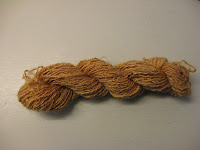I've had a very basic go at dyeing wool with some Koolaid in the microwave & although I didn't get exactly the results I wanted, it was OK. But the process of using natural plants etc. for dyeing filled me with a lot more pleasure even if it is much harder work. I would love to be able to do this sort of thing on a regular basis, but I feel that with time constraint it will be one of the things that I will keep for my retirement, just another thing to add to my increasingly long list, I'm going to be busier than I am now! I can see why people are drawn into dyeing, especially with the lovely soft colours that you get from using natural dyes. It somehow feels a bit like Alchemy, especially when you see how different modifiers change the yarn to different shades. I will try to have a go with some of this Texel fleece that I've got & see how it dyes up, but I need to get myself some equipment & quite a few hours to myself first.
So these are the 2 skeins I dyed, they are from some rather badly spun Wensleydale that I spun last year, I don't particularly want to knit with them but they will probably be OK to add texture to weaving.
This first one was dyed with rhubarb root and then modified with alkaline in the form of washing soda. The piec
 e that we did for our sample cards was much more of a taupe, sort of pinkish colour which was what I wanted, but this has come out much more of a mustard colour. It could be something to do with the fact that the power blew out in the room we were using, although Jenny was careful not to plug all the hotplates & the boiler into the same plugs so the circuits weren't overloaded, & no-one could find the trip switch. It took a good half hour before the hall Chairman arrived to fix it, so the pans were standing for quite a long time before we had decided to transfer them into the hallway & kitchen where the points were still working.
e that we did for our sample cards was much more of a taupe, sort of pinkish colour which was what I wanted, but this has come out much more of a mustard colour. It could be something to do with the fact that the power blew out in the room we were using, although Jenny was careful not to plug all the hotplates & the boiler into the same plugs so the circuits weren't overloaded, & no-one could find the trip switch. It took a good half hour before the hall Chairman arrived to fix it, so the pans were standing for quite a long time before we had decided to transfer them into the hallway & kitchen where the points were still working.
This second one was dyed in madder. It's a lovely warm, rich colour & I look forward to using madder more for dyeing in the future
So how did we go about the dyeing process? Well first our skeins were given a good soaking in water, one person's wool was still too greasy so she had to wash it in some dishwashing liquid to get the lanolin out. The dye won't take well if there's grease in the fleece as it were, & will be patchy when it's dyed. Once the wool had soaked well it was put into the boiler with an alum mixture. Without my notes I can't remember the exact amount, but I think it was 100gm of alum to 1 kilo of yarn, but don't take that as gospel. The wool was brought up to simmering & left to simmer in the boiler until we were ready for it. If you boil wool it won't harm it as it's already been hot washed to remove the lanolin & I wash my skeins again once they've been spun so they're pretty well shrunk by then. The dye pots were prepared by putting the dyestuff into them & giving them a good simmering to release the dye, then strained & they were ready, so we chose which ones we wanted to use. The madder was popular & we had 2 pots of that going, one was partly exhausted from the morning's dyeing when we'd been doing our sample pieces, so the results from that were more pink than red/orange. I chose the new pot to get the more vibrant colour & the pot of rhubarb root to which Jenny added extra dye extracts rather than boiling up more of the actual root which would have been too time consuming. Then skeins into pots & the fuses blew out, but we managed to get our skeins dyed & I was more than happy with my efforts. We also had some superb cup cakes which were brought in by Julie, a new member of the Guild. She was signed up very quickly I noticed!
Next time I'll post about preparing fleece for spinning
No comments:
Post a Comment